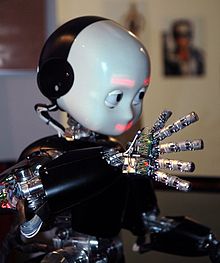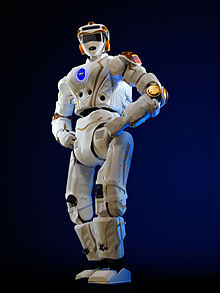Atlas from Boston Dynamics
A humanoid robot is a robot with its body shape built to resemble the human body.
The design may be for functional purposes, such as interacting with
human tools and environments, for experimental purposes, such as the
study of bipedal locomotion,
or for other purposes. In general, humanoid robots have a torso, a
head, two arms, and two legs, though some forms of humanoid robots may
model only part of the body, for example, from the waist up. Some
humanoid robots also have heads designed to replicate human facial
features such as eyes and mouths. Androids are humanoid robots built to aesthetically resemble humans.
Purpose
iCub robot at the Genoa Science Festival, Italy, in 2009
Humanoid robots are now used as research tools in several scientific
areas.
Researchers study the human body structure and behavior (biomechanics)
to build humanoid robots. On the other side, the attempt to simulate the
human body leads to a better understanding of it. Human cognition is a
field of study which is focused on how humans learn from sensory
information in order to acquire perceptual and motor skills. This
knowledge is used to develop computational models of human behavior and
it has been improving over time.
It has been suggested that very advanced robotics will facilitate the enhancement of ordinary humans.
Although the initial aim of humanoid research was to build better orthosis and prosthesis
for human beings, knowledge has been transferred between both
disciplines. A few examples are powered leg prosthesis for
neuromuscularly impaired, ankle-foot orthosis, biological realistic leg
prosthesis and forearm prosthesis.
Besides the research, humanoid robots are being developed to
perform human tasks like personal assistance, through which they should
be able to assist the sick and elderly, and dirty or dangerous jobs.
Humanoids are also suitable for some procedurally-based vocations, such
as reception-desk administrators and automotive manufacturing line
workers. In essence, since they can use tools and operate equipment and
vehicles designed for the human form, humanoids could theoretically
perform any task a human being can, so long as they have the proper software. However, the complexity of doing so is immense.
They are also becoming increasingly popular as entertainers. For example, Ursula,
a female robot, sings, plays music, dances and speaks to her audiences
at Universal Studios. Several Disney theme park shows utilize
animatronic robots that look, move and speak much like human beings.
Although these robots look realistic, they have no cognition or physical
autonomy. Various humanoid robots and their possible applications in
daily life are featured in an independent documentary film called Plug & Pray, which was released in 2010.
Humanoid robots, especially those with artificial intelligence algorithms, could be useful for future dangerous and/or distant space exploration missions, without having the need to turn back around again and return to Earth once the mission is completed.
Sensors
A sensor
is a device that measures some attribute of the world. Being one of the
three primitives of robotics (besides planning and control), sensing
plays an important role in robotic paradigms.
Sensors can be classified according to the physical process with
which they work or according to the type of measurement information that
they give as output. In this case, the second approach was used.
Proprioceptive sensors
Proprioceptive sensors sense the position, the orientation and the speed of the humanoid's body and joints.
In human beings the otoliths and semi-circular canals (in the
inner ear) are used to maintain balance and orientation. In addition
humans use their own proprioceptive sensors (e.g. touch, muscle
extension, limb position) to help with their orientation. Humanoid
robots use accelerometers to measure the acceleration, from which velocity can be calculated by integration; tilt sensors
to measure inclination; force sensors placed in robot's hands and feet
to measure contact force with environment; position sensors, that
indicate the actual position of the robot (from which the velocity can
be calculated by derivation) or even speed sensors.
Exteroceptive sensors
An artificial hand holding a lightbulb
Arrays of tactels can be used to provide data on what has been touched. The Shadow Hand uses an array of 34 tactels arranged beneath its polyurethane skin on each finger tip. Tactile sensors also provide information about forces and torques transferred between the robot and other objects.
Vision
refers to processing data from any modality which uses the
electromagnetic spectrum to produce an image. In humanoid robots it is
used to recognize objects and determine their properties. Vision sensors work most similarly to the eyes of human beings. Most humanoid robots use CCD cameras as vision sensors.
Sound sensors allow humanoid robots to hear speech and environmental sounds, and perform as the ears of the human being. Microphones are usually used for this task.
Actuators
Actuators are the motors responsible for motion in the robot.
Humanoid robots are constructed in such a way that they mimic the human body, so they use actuators that perform like muscles and joints,
though with a different structure. To achieve the same effect as human
motion, humanoid robots use mainly rotary actuators. They can be either
electric, pneumatic, hydraulic, piezoelectric or ultrasonic.
Hydraulic and electric actuators have a very rigid behavior and
can only be made to act in a compliant manner through the use of
relatively complex feedback control strategies. While electric coreless
motor actuators are better suited for high speed and low load
applications, hydraulic ones operate well at low speed and high load
applications.
Piezoelectric actuators generate a small movement with a high
force capability when voltage is applied. They can be used for
ultra-precise positioning and for generating and handling high forces or
pressures in static or dynamic situations.
Ultrasonic actuators are designed to produce movements in a
micrometer order at ultrasonic frequencies (over 20 kHz). They are
useful for controlling vibration, positioning applications and quick
switching.
Pneumatic actuators operate on the basis of gas compressibility.
As they are inflated, they expand along the axis, and as they deflate,
they contract. If one end is fixed, the other will move in a linear trajectory. These actuators are intended for low speed and low/medium load applications. Between pneumatic actuators there are: cylinders, bellows, pneumatic engines, pneumatic stepper motors and pneumatic artificial muscles.
Planning and control
In planning and control, the essential difference between humanoids and other kinds of robots (like industrial ones) is that the movement of the robot must be human-like, using legged locomotion, especially biped gait.
The ideal planning for humanoid movements during normal walking should
result in minimum energy consumption, as it does in the human body. For
this reason, studies on dynamics and control of these kinds of structures has become increasingly important.
The question of walking biped robots stabilization on the surface
is of great importance. Maintenance of the robot’s gravity center over
the center of bearing area for providing a stable position can be chosen
as a goal of control.
To maintain dynamic balance during the walk,
a robot needs information about contact force and its current and
desired motion. The solution to this problem relies on a major concept,
the Zero Moment Point (ZMP).
Another characteristic of humanoid robots is that they move,
gather information (using sensors) on the "real world" and interact with
it. They don’t stay still like factory manipulators and other robots
that work in highly structured environments. To allow humanoids to move
in complex environments, planning and control must focus on
self-collision detection, path planning and obstacle avoidance.
Humanoid robots do not yet have some features of the human body.
They include structures with variable flexibility, which provide safety
(to the robot itself and to the people), and redundancy of movements,
i.e. more degrees of freedom
and therefore wide task availability. Although these characteristics
are desirable to humanoid robots, they will bring more complexity and
new problems to planning and control. The field of whole-body control
deals with these issues and addresses the proper coordination of
numerous degrees of freedom, e.g. to realize several control tasks
simultaneously while following a given order of priority.




